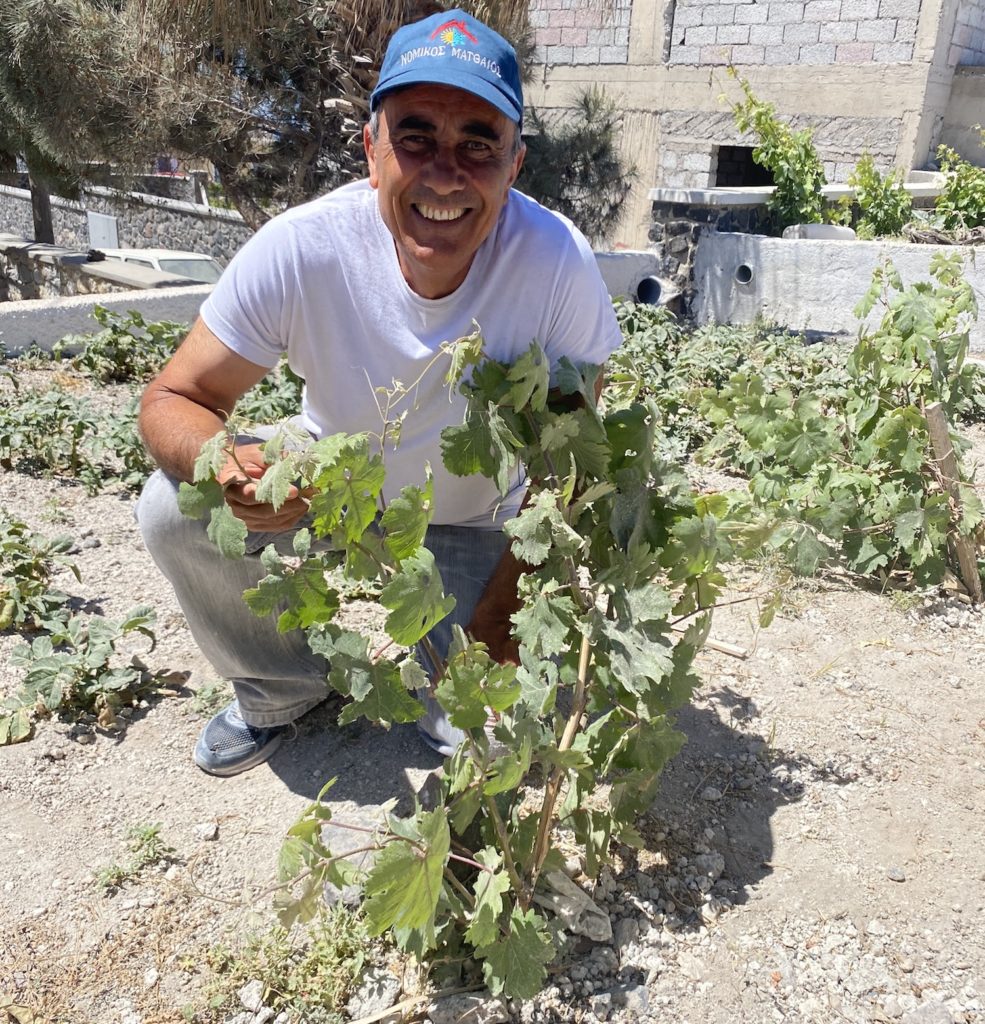Visiting Gavalas Winery
This beautiful family winery, just a cobblestone walk away from Megalochori village, is now being tended by the fifth generation. With a wine history of over 300 years, Gavalas is one of Santorini’s longest-standing wineries which has been protecting and guarding traditional native varieties and viticultural traditions as well as making premium wines with artisanal traditions.

In this interview, fifth generation vigneron of the family Vagelis Gavalas tells us all about the tradition of kouloura vines, or basket vines, in Santorini and explores the terroir of this island and some of the key grape varieties grown:
Tasting the wines of Gavalas
Aidani 2019
This is the second most-known white grape of Santorini and the third-most planted after Assyrtiko and Mandilaria, around 5 to 7% of the island’s vines. It used to be use quite a lot in traditional Santorini Assyrtiko wines but now you’ll find it in Vinsanto or some easier-drinking blends, but Gavalas is making a 100% Aidani. It has a really pure and attractive, aromatic nose with jasmine, green melon and a touch of candied lemon, with fresh, supple and quite juicy with a pithy bitterness on the finish. A wine to enjoy now and certainly versatile for a range of foods.
Katsano 2020
This Katsano has a touch of Gaidouria in the blend, both old white varieties grown in Santorini but quite rare to find. It has a delicate nose of blossom and white peach with creamy notes, and with a medium body and a slightly tangy, salty and fresh finish. A lovely wine to enjoy with seafood on the beach!
Santorini 2020
This is their flagship wine: a monovarietal Assyrtiko coming from different growers around the island. Made in a youthful style with a direct press and five months on the lees, the style is more austere with a saline and linear style with vibrant, mouthwatering acidity that lingers. Subtle, delicate notes of white peach and lemon zest, this is classic Santorini — well poised, elegant and refreshing. And the blue bottle isn’t going to look bad on your Instagram post either!
Santorini Natural Ferment 2019
This is their wild fermented Assyrtiko which is left on the lees a bit longer than their classic Assyrtiko (eight months instead of five) and also passes through old barrels. All of this leads to a slightly wilder and more intense nose with of chamomile and flint and the wine itself is much richer in the palate with a full body which is carried off nicely by the taut acidity. A more intellectual wine which will do well with some decanting.
Nyxtepi 2019
This is a ‘Nykteri’ style of Assyrtiko, which was traditionally made in the evening following a day of harvest, but nowadays it is made by day but does take the tradition of oak ageing. It spends four months in oak barrels, which gives it more structure in the palate although doesn’t impede on the salty minerality and vibrancy of Assyrtiko. There’s a nice creaminess to the finish on this wine.
Voudomato 2019
The family started making this ancient native variety in order to protect it from facing extinction. This is a really deep coloured grape, and with barely four hours of pressing it gives this rosé a deep cherry colour. In fact the deep colour, which would regularly stain family’s wineries, was one of the reason that it lost favour. However, the Gavalas family were keen to keep this variety on the island and make this characterful rosé from it. With notes of molasses, butterscotch and pomegranate on the nose, it gives you the illusion it might be sweet but the palate is fresh, tangy and bone dry. A food-friendly rosé.
Xenoloo 2019
This blend of Mavrotragano (50%), Mandilaria (45%) and Athiri (5%) is named Xenoloo which means ‘foreigner’ and was used to describe all grapes except Assyrtiko, which symbolises this blend. Somewhere between a deep-coloured rosé and light red, this wine has spicy and herbal notes on the nose with a crunchy finish and fine tannins. An appealing juicy wine which would work nicely with lighter grilled meats.
Mavrotragano 2017
This is a 100% Mavrotragano varietal wine which some wineries have been championing as worth saving before it goes extinct making it today’s favourite red wine of the island. Gavalas’ Mavrotragano is fresh in style with notes of black cherries with interesting layers of paprika, cinnamon and thyme on the nose and a fresh, spicy finish. With piquant acidity and fine tannins, it’s a lively wine that will work nicely with richer Greek lamb dishes.
Vinsanto 2012
This traditional sweet wine is made with Assyrtiko and 10% Aidani and 5% Athiri by sun-drying the grapes for around two weeks (depending on the strength of the sun). After pressing they leave it to spontaneously ferment in 80 year old Russian oak barrels, which can take months, and it usually stops fermentation at 270 gr/l with 12% alcohol. After several years in barrel the result is a deep, mocha-coloured wine with rich and complex aromas of prune, chocolate, soaked raisins and a long, complex finish with a bright acidity balancing out the luscious finish. A wine for baklava.

George Gravalas at his nursery with other native varieties of Santorini
Read our guide to the wines of Santorini.
Learn more about Gavalas winery.

